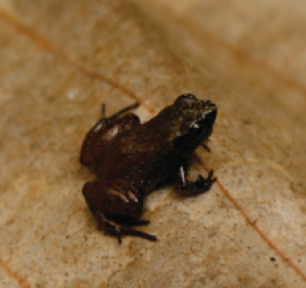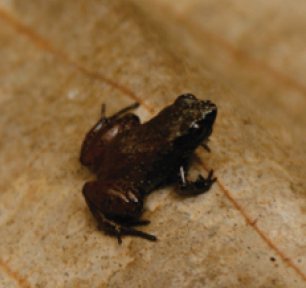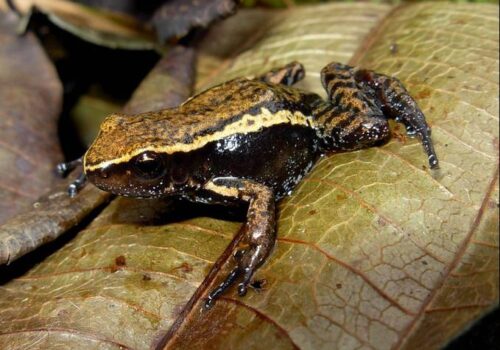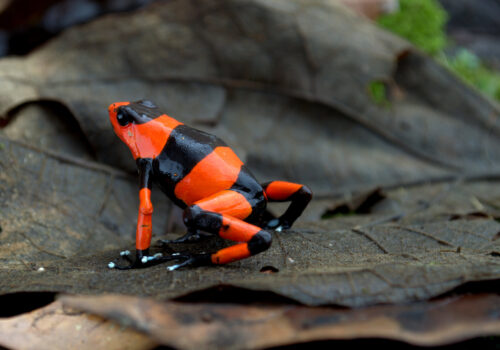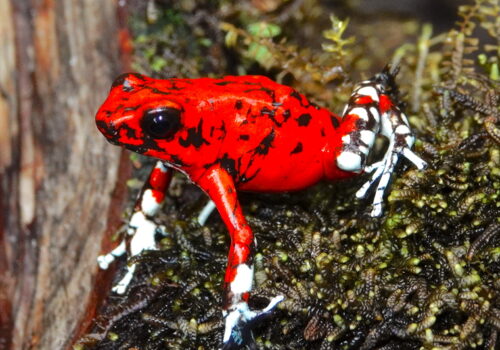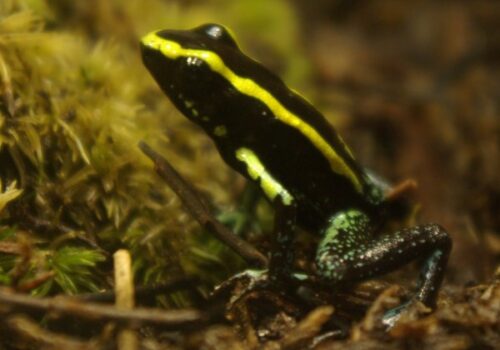- Discovering Adelophryne gutturosa: The Elusive Jewel of the Atlantic Rainforest
- Taxonomy and Classification
- Natural Habitat: A Mosaic of Life in the Atlantic Rainforest
- Physical Characteristics and Unique Adaptations
- Behavior and Life Cycle
- Ecological Role: Small Frog, Significant Impact
- Threats and Conservation Status
- Cultural and Scientific Significance
- Conclusion: Protecting the Hidden Jewels of the Rainforest
Discovering Adelophryne gutturosa: The Elusive Jewel of the Atlantic Rainforest#
Hidden within the lush, moisture-rich depths of South America’s Atlantic Rainforest lies a tiny amphibian seldom noticed yet profoundly intriguing—the Adelophryne gutturosa. This small, secretive frog, scarcely larger than a fingertip, belongs to a distinctive group that thrives neither in sprawling ponds nor vibrant rivers, but instead within the leaf-littered floor of the world’s most endangered forests.
With scientific curiosity and enthusiasm for conservation, we journey into the hidden micro-universes of the forest understory. Adelophryne gutturosa, though elusive, captivates both seasoned herpetologists and enthusiastic amateurs alike, not only due to its diminutive size and captivating appearance but also its subtle yet significant role within this delicate ecosystem. Let’s delve into the life and lore of this tiny amphibian, uncovering its beauty, mysteries, and the pressing need to safeguard its habitat.
Taxonomy and Classification#
A Closer Look at the Genus Adelophryne#
Adelophryne gutturosa belongs to the family Eleutherodactylidae, a fascinating assemblage of frogs renowned for their unique reproductive adaptations. The genus Adelophryne, specifically, consists of miniature frogs renowned for their incredible size variability, often featuring among some of the smallest amphibians in the world. The scientific name “gutturosa” originates from the Latin term “guttur,” meaning “throat,” aptly describing the species’ distinctive vocal sac and call.
Closely related species, such as Adelophryne maranguapensis and Adelophryne pachydactyla, share similar ecological niches and physical traits, but Adelophryne gutturosa is notable for its own unique adaptations and subtle physical variations, distinguishing it clearly among peers.
Natural Habitat: A Mosaic of Life in the Atlantic Rainforest#
The Atlantic Rainforest, known locally as the Mata Atlântica, is a verdant treasure straddling Brazil’s eastern coastline, a biodiversity hotspot teeming with diverse plants, animals, and microorganisms. Unfortunately, it is also one of the world’s most threatened habitats, fragmented drastically due to expanding agriculture, industrialization, and urban development.
The Leaf-littered Kingdom#
Within this threatened paradise, the Adelophryne gutturosa persists in secrecy, primarily occupying leaf litter on the forest floor. Beneath a dense canopy, they seek refuge in humid microhabitats—under fallen leaves, amid damp moss, or within small natural crevices. This moisture-rich environment grants the frog perfect concealment, protection, and a readily available insect buffet.
Intricately dependent on these cool, shaded areas, Adelophryne gutturosa thrives in regions with high rainfall, typically in subtropical climates. Such a habitat selection illustrates how these frogs have evolved to exploit specific environmental niches, an adaptation vital to their survival—one that tightly links their fate with that of the Atlantic Rainforest itself.
Physical Characteristics and Unique Adaptations#
Tiny Size, Grand Impact#
At first glance, Adelophryne gutturosa’s striking feature is undoubtedly its miniature stature. Adult frogs measure a mere 10-15 millimeters, making them among the smaller vertebrates on Earth. Despite its modest dimensions, this frog exudes remarkable beauty upon closer inspection. Its slender yet sturdy limbs, agile fingers, and complex skin texture all contribute to its intricate adaptation to an exacting forest environment.
The color palette of Adelophryne gutturosa typically blends seamlessly with the environment—earthy shades of browns and grays camouflaged with cryptic patterns of tiny flecks and irregular blotches. This subtle coloration keeps it discreetly hidden from predators, allowing it, in turn, to stealthily pursue minuscule prey among damp leaves and mossy coverts.
Adaptations for Secrecy and Survival#
Apart from coloration, Adelophryne gutturosa exhibits anatomical adaptations that facilitate its leaf-litter existence. The small size and delicate limbs permit movement through narrow crevices, enhancing its ability to evade predators and ambush small insects and arthropods. Its granular skin texture performs another critical function—optimizing moisture retention, helping to regulate sensitive skin in a habitat where drying out poses constant danger.
Behavior and Life Cycle#
Feeding Habits: Ambush Specialist#
Adelophryne gutturosa employs a sit-and-wait hunting strategy, patiently hiding within the shadows until small invertebrates—ants, mites, and tiny insects—wander within striking distance. Its diminutive size offers an advantage, greatly expanding the range of appropriate prey, enabling efficiency in caloric intake and enhancing its survival odds within a competitive habitat.
Mating and Vocalization#
Among the most fascinating behaviors exhibited by this species is its nuanced breeding process. Males produce a characteristic, high-pitched chirping call—a melodic yet subtle chorus typical of humid tropical nights. Indeed, the expanded vocal sacs give Adelophryne gutturosa its namesake, playing a unique role in attracting females amid densely packed forest acoustics.
Egg Development and Direct Development Strategy#
Unlike more familiar amphibians who pass through aquatic tadpole stages, Adelophryne gutturosa exhibits direct development, meaning embryos develop fully within the egg, bypassing the vulnerable tadpole stage altogether. This reproductive adaptation enhances the frog’s survival odds; eggs, carefully deposited in moist crevices or leaf litter, soon hatch into froglets, miniature replicas of their parents, ready to explore their tiny world immediately.
Ecological Role: Small Frog, Significant Impact#
In the intricate ecological web of the Atlantic Rainforest, Adelophryne gutturosa fulfills a critical role disproportionate to its size. Acting simultaneously as predator and prey, the species significantly impacts insect populations, influencing wider ecological balances. Moreover, as prey, it supports a diverse array of woodland fauna, from larger amphibians and small reptiles to birds, exemplifying a web of interactions shaping life within these tropical forests.
The Indicator Species Advantage#
Due to their extreme sensitivity to environmental disturbances, amphibians like Adelophryne gutturosa serve as biological indicators. Their presence—or absence—signal ecological wellbeing or warning alarms about habitat degradation, pollution, or climate shifts. Tracking populations of this tiny frog can thus provide invaluable insights, hinting strongly at the necessity for conservation measures.
Threats and Conservation Status#
Sadly, despite their petite size and secluded lifestyles, Adelophryne gutturosa faces significant existential threats. Chief among these is the profound habitat loss and fragmentation within their Atlantic Rainforest home. Deforestation driven by urban encroachment, agricultural expansion, and timber exploitation critically fragments once-connected populations. Such fragmentation isolates individuals, leading to reduced genetic exchange, heightened mortality risks, and declining population resilience.
IUCN Status and Ongoing Efforts#
Currently, Adelophryne gutturosa is classified by the International Union for Conservation of Nature (IUCN) as a species of concern, although insufficient data exist to precisely establish clear population trends. Given the frog’s cryptic lifestyle and inaccessible forest habitats, researchers continue gathering data that can shape future protective measures, guide conservation initiatives, and support policy interventions aimed at safeguarding habitat and biodiversity.
Cultural and Scientific Significance#
Though Adelophryne gutturosa might not boast prominent cultural symbolism, it remains emblematic of the broader plight affecting endangered forest ecosystems. Scientifically, its fascinating biological adaptations, small size, direct development, and ecological sensitivity make it an invaluable research subject, illuminating broader ecological principles, evolutionary pathways, and climate vulnerability impacting amphibians worldwide.
Conclusion: Protecting the Hidden Jewels of the Rainforest#
Delving into the fascinating life of Adelophryne gutturosa reveals layers of wonder within ecosystems often overlooked. This small yet significant species reminds us eloquently, subtly, but insistently, of our intimate connections with the natural world—and our critical role in protecting it. Awareness, education, and conservation action starting at home—through responsible living, advocacy, and support for ecological projects—can play pivotal roles.
In nurturing respect and protection for such cryptic yet precious forms of life, we secure not just one small frog’s future but the entirety of biodiversity that enfolds our planet. Adelophryne gutturosa stands as humble evidence that even the smallest creatures can possess profound ecological significance and should compel us all toward mindful stewardship and committed conservation.



